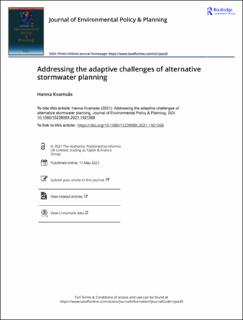| dc.contributor.author | Kvamsås, Hanna | |
| dc.date.accessioned | 2022-03-21T14:19:48Z | |
| dc.date.available | 2022-03-21T14:19:48Z | |
| dc.date.created | 2021-09-23T13:39:32Z | |
| dc.date.issued | 2021 | |
| dc.identifier.issn | 1523-908X | |
| dc.identifier.uri | https://hdl.handle.net/11250/2986582 | |
| dc.description.abstract | Municipal water sectors shift from building traditional grey stormwater infrastructure to ambitious plans for holistic blue–green infrastructure due to climate vulnerability. The shift requires new ways of thinking, working, and collaborating, and we need to understand and address the new planning challenges the shift creates. While existing stormwater literature explores a range of technical, institutional, and financial barriers to alternative stormwater implementation, we hold the shift requires a deeper understanding of holistic and flexible stormwater management approaches. In this context, we investigate adaptive challenges like norms, practices, uncertainty, and new ways of collaborating across sectors in alternative stormwater planning in Norway. The studied planning processes exemplify how the need for making stormwater measures legally binding in municipal planning changes work practices in municipal water sectors. A novelty of the paper is that it shows how water departments take leadership of formal planning processes and adopt the planning department's language and working methods. We find that the studied municipalities promote cross-sectoral collaborative approaches that create space for professional negotiation and mediation and invite a deeper understanding of other's interests and views. We hold that such approaches could contribute to more holistic and flexible planning approaches, securing long-term sustainable stormwater management. | en_US |
| dc.language.iso | eng | en_US |
| dc.publisher | Routledge | en_US |
| dc.rights | Attribution-NonCommercial-NoDerivatives 4.0 Internasjonal | * |
| dc.rights.uri | http://creativecommons.org/licenses/by-nc-nd/4.0/deed.no | * |
| dc.title | Addressing the adaptive challenges of alternative stormwater planning | en_US |
| dc.type | Journal article | en_US |
| dc.type | Peer reviewed | en_US |
| dc.description.version | publishedVersion | en_US |
| dc.rights.holder | Copyright 2021 The Author(s) | en_US |
| cristin.ispublished | true | |
| cristin.fulltext | original | |
| cristin.qualitycode | 1 | |
| dc.identifier.doi | 10.1080/1523908X.2021.1921568 | |
| dc.identifier.cristin | 1937675 | |
| dc.source.journal | Journal of Environmental Policy and Planning | en_US |
| dc.source.pagenumber | 809-821 | en_US |
| dc.identifier.citation | Journal of Environmental Policy and Planning. 2021, 23 (6), 809-821. | en_US |
| dc.source.volume | 23 | en_US |
| dc.source.issue | 6 | en_US |

